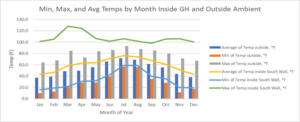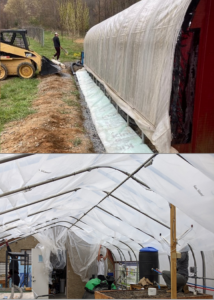The Nexus group launched two research projects this year at their existing facility located at the Watauga County landfill. The team is working on an energy efficiency retrofit to improve the insulation and ventilation systems and performing a feasibility study with an Earth-Air Heat Exchange (EAHE) system for high tunnels. The goal of these projects is to provide local farmers in the high country with “best practice” resources for energy efficiency and microclimate control in high tunnel crop production.
Background
Growing season extension utilizing greenhouses has been suggested as a key strategy to overcome regional agricultural challenges associated with mountainous terrain and climate1. High tunnels’ relatively inexpensive installation cost attracts small-scale farmers in the high country, so they are commonly used for growing season extension either by passive means or with active heating and ventilation systems. The high tunnel is a simple frame structure greenhouse, capitalizing on the greenhouse effect and microclimate2, but the high heat loss rate of polyethylene- the main material of the high tunnel, does not guarantee its envelope thermal insulation in the cold climate that exists in the high country. For example, high tunnels with a single polyethylene have a heat loss rate (U-value) of 1.15 Btu/ ft ºF hr and an infiltration rate of 0.8 air change/hr3. Therefore, a spring cold snap in the region puts high tunnel crop production at risk of freezing damage or a burden of heating cost. In addition, improper design/size of ventilation systems can cause large daily temperature swings as well as high humidity that tends to cause plant diseases, although microclimate inside a high tunnel is more controllable compared to field production.
New Projects:
1. NEXUS Greenhouse Energy Efficiency Retrofit Project
The Nexus facility located at the Watauga County Landfill contains a 20’ by 35’ high tunnel greenhouse. The temperature data of the Nexus greenhouse measured in 2020 without heating and a single film layer showed the lowest greenhouse air temperature fell below freezing even in May (figure 1). It also overheats (green line) at some point each month, especially in March and April. Before the sidewalls were rolled up, the greenhouse air temperature reached over 120°F. It was determined that the exhaust fan was not properly located or sized to exhaust the overheated air.
The retrofit project started with support from the Appalachian Energy Center (AEC) to increase the energy efficiency of the Nexus greenhouse. The first phase of the project is to improve the insulation and ventilation systems that includes; installing a second film layer, air-inflation, sufficient-size exhaust and circulation fans, automatic roll-up sides, and ground skirts (figure 2). The impacts of the retrofit on internal air and ground temperature control will be quantified by analyzing pre- and post-installation data. The second phase will include designing and installing an efficient hydroponic heating system that will increase renewable energy collection and provide the desired temperature consistently to the crops. The retrofit project aims to strengthen the functionality of the Nexus facility as a center of education, research, and outreach for sustainable agricultural technology.

Figure 1. Nexus greenhouse interior and exterior air temperature in 2020
2. Earth-Air Heat Exchange (EAHE) System for High Tunnels: Feasibility Study
The EAHE is a technique that transfers heat from or to the ground by circulating air through buried tubes, using the relatively constant temperature of the earth. It can be used alone or for pre-conditioning purposes to reduce the energy load of a building. EAHE technique is suggested as a good option for greenhouses with moderate cooling demands for climates with large temperature differences between summer and winter, day and night4. However, the performance of an EAHE system is directly dependent on burial depth, length of pipe, air velocity, soil properties, etc5. In addition, little research has been done on the the thermal performance of EAHE with a high tunnel greenhouse, so its feasibility is still unknown for the climate in our region.
With support from the Research Institute for Environment, Energy, and Economics (RIEEE) the team will study regional parameters to provide fundamental information in designing an EAHE system such as; local soil properties, ground temperature over depth, and develop a simple modeling tool to estimate thermal performance of EAHEs to assist in early-stage design for the Nexus greenhouse. This project will provide informative technical data on the application of EAHE to high tunnel greenhouses in the high country region.

Figure 2. Nexus greenhouse retrofit: Phase 1
References
- Local Food Research Center (LFRC). (2012). Food and Farm Assessment for a Five-County: Region in the Southern Appalachians: Alleghany, Ashe, Watauga, Wilkes, and Johnson County. Asheville, North Carolina: Appalachian Sustainable Agriculture Project.
- Giacomelli, G. A. (2009). Engineering principles impacting high-tunnel environments. HortTechnology, 19(1), 30-33.
- Rafferty, K. D. (1998). Greenhouses. Geothermal direct use engineering and design guidebook. 3rd edition, Geo-Heat Center, Klamath Falls, OR, 307, 332.
- Li, G., Tang, L., Zhang, X., Dong, J., & Xiao, M. (2018). Factors affecting greenhouse microclimate and its regulating techniques: A review. In IOP Conference Series: Earth and Environmental Science. Barcelona, Spain.
- Bisoniya, T. S., Kumar, A., & Baredar, P. (2014). Study on calculation models of earth-air heat exchanger systems. Journal of Energy, 2014.